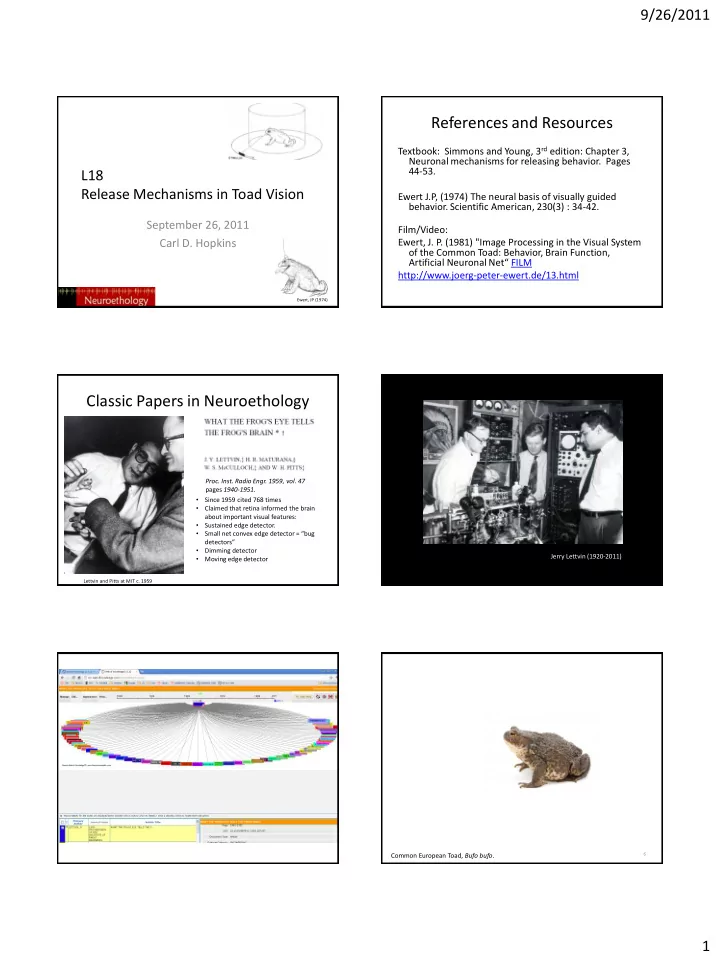

9/26/2011 References and Resources Textbook: Simmons and Young, 3 rd edition: Chapter 3, Neuronal mechanisms for releasing behavior. Pages 44-53. L18 Release Mechanisms in Toad Vision Ewert J.P, (1974) The neural basis of visually guided behavior. Scientific American, 230(3) : 34-42. September 26, 2011 Film/Video: Carl D. Hopkins Ewert, J. P. (1981) "Image Processing in the Visual System of the Common Toad: Behavior, Brain Function, Artificial Neuronal Net“ FILM http://www.joerg-peter-ewert.de/13.html Ewert, JP (1974) Classic Papers in Neuroethology Proc. Inst. Radio Engr. 1959, vol. 47 pages 1940-1951. • Since 1959 cited 768 times • Claimed that retina informed the brain about important visual features: • Sustained edge detector. • Small net convex edge detector = “bug detectors” • Dimming detector Jerry Lettvin (1920-2011) • Moving edge detector Lettvin and Pitts at MIT c. 1959 Bufo bufo , the common toad Common European Toad, Bufo bufo . 6 1
9/26/2011 In response to a moving predator: Prey capture in toads is a stereotyped sequence of events avoidance In response to: Planting down 1 a worm moving in the lateral visual field turn to orient in frontal visual Turn to orient -- brings object into binocular field of view. Binocular fixation field, binocular fixation Planting down 2 snap swallow wiping mouth snapping Swallowing Crouching Wiping mouth crouching Ewert, JP (1974) Ewert, JP (1974) 8 7 Experimental Set Up Video of Toad Behavior and Neuroethology http://www.joerg-peter-ewert.de/13.html Toad held in a glass container at fixed distance from object. Stimuli: square, moving bar (worm-like) Turning response strong response weak response turns 9 10 Kassel Germany NATO Symposium on Vertebrate Neuroethology, August 1981 11 Jörg-Peter Ewert 12 2
9/26/2011 Small and Large Objects Behavioral Responses Square Vertical moving bar Weak, decreases with increasing turn toward if small length turn away if large Horizontal moving bar: Small (1-16 ) strong response, increases with length Large (20+ ) Bar + square: (avoid) - decreases with distance of square, d, but then increases again (as bar and square are separated) 13 14 Response Invariance Toad Visual System Identical response to differing stimuli given under varying conditions. e.g. -Size stimulus -Color -Background -Direction of movement Responses: W = toad oriented and snapped (worm response) A = toad turns away (avoids) anti-worm response 15 Ewert (1974) Sci. American. 16 From Carew (2000) Ch. 4 The Retina: a neural network The vertical pathway from receptor to ganglion cell glutamate is released by receptors onto bipolar cells John Dowling 1968 John Dowling 1968 17 18 3
9/26/2011 How do Ganglion cells respond? Consider 3 types, with differing size ERFs. Receptive Fields of Retinal Ganglion Cells On-center, off-surround cell Off-center, on-surround cell 19 20 From Carew (2000) Ch. 4 Responses of Retinal Ganglion Cells --- +++ ++ ++ +++ ++ + + 22 Ewert, JP. Trends Neurosci. (1997) 20, 332 – 339 ON center Lateral Inhibition OFF center glutamate released ionotropic AMPA metabotropic cAMP closes Na + channels 23 24 4
9/26/2011 Two projections of retina Thalamic Neuron, Type TH3 • Main projection: to optic tectum (midbrain) • To Thalamus-pre-tectum Large receptive fields (receives inputs only from R3, R4. Excitatory throughout. Larger stimulus: stronger response. 26 25 Circuitry Between Tectum and Tectal Neuons, Type T5(1) and T5(2) Thalamus Pre-Tectum Stimulation in optic tectum causes cells in thalamus to fire. Cells are excited by visual stimuli. Stimulation in thalamus pretectum causes cells in tectum to be inhibited. (Cells were responding to visual stimulus). 27 28 29 30 From Carew (2000) Ch. 4 5
9/26/2011 32 From Carew (2000) Ch. 4 Tectal Stimulation Lessons from Toad Vision Electrical stimulation results: 1. Toads discriminate complex visual stimuli based on size, direction of motion, shape in a large variety of visual contexts (background, color, contrasts, outline) 2. Robust adaptive behavior in laboratory: following and snapping in response to “worm”, no response or avoidance of “ antiworm ”. In optic tectum: 3. No prey detectors or predator detectors in retina, instead circular center surround RFs. - frog orients to different 4. RGC project to optic tectum (midbrain) and pretectum (thalamus). parts of visual space. 5. OT: respond to small square, worm, but not large square, not antiworm. 6. PT: respond to large square, antiworm, not worm, not small square. (Compare with map). 7. OT organizes strike behavior, PT organizes avoidance. 8. Does toad with PT lesion remain immobile when given a large stimulus? No, PT lesioned toads strike at any object. Stimulation in thalamus (pre- 9. Neurons in OT now respond to all types of stimuli, even large. tectal area) evokes 10. PT respond to large objects, initiate avoidance, and inhibit OT. 11. OT neurons respond to any object, increasing with increasing size, in addition, avoidance response OT neurons stimulate approach (and snapping). 12. The net behavior is the combination of excitation and inhibition. 34 33 References Ewert, J. P. (1974) The neural basis of visual guided behavior. Sci. American 230(3):34-42. Ewert, J. P. (1980) Neuroethology: An Introduction to Neurophysiological Basis of Behavior. Springer. Washington, D. C. Ewert, J.P. (1999) Neural correlates of key stimulus and releasing mechanisms: A case study and two concepts. Trends in Neuroscience. 20(8):332-39. Carew, T. (2000) Behavioral Neurobiology. Sinauer Associates. Sunderland, MA. D. L. Wang and M. A. Arbib (1991) How does the toad's visual system discriminate different worm-like stimuli? Biological Cybernetics, 1990, 64(3): 251-261. 35 6
Recommend
More recommend